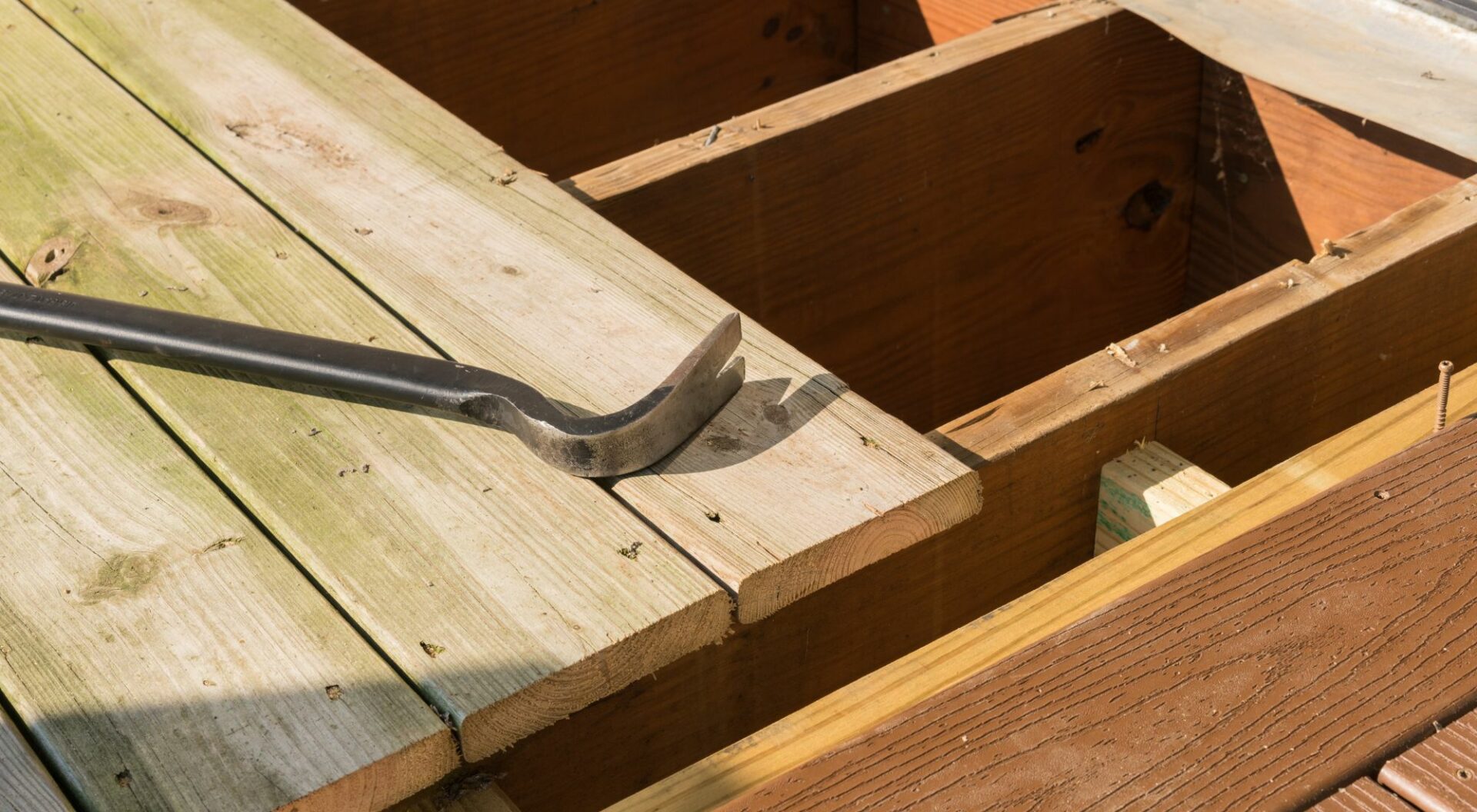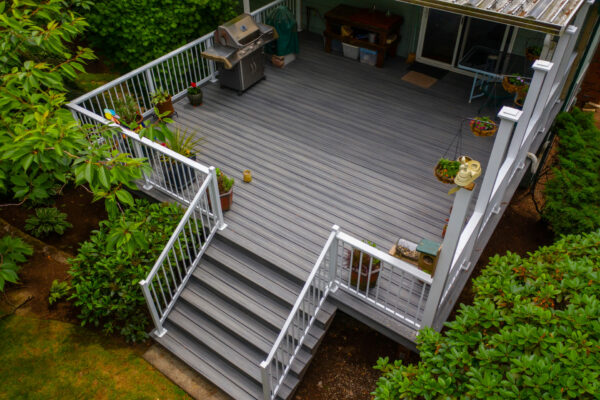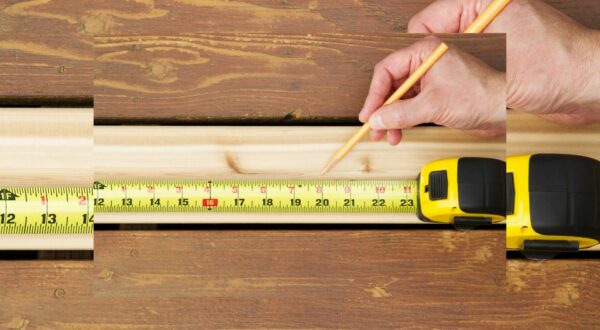How To Replace Wooden Deck Boards: When To Repair or Replace Your Deck
October 25th, 2023 | by Jim Gates

Here in Oregon, we’re lucky to have great porch weather the majority of the year.
Whether you’re bundled up with a coffee in the fall or sipping a chilled glass of wine in the spring, there’s nothing like spending time outdoors from the comfort of your deck.
But lately, you’ve noticed you’re having to sidestep more and more boards that have warped and are now seriously sticking up. You could try to fix it yourself, right? How much does it cost to replace deck boards, after all?
If you’re faced with a deteriorating deck, you’re likely questioning whether you should repair the damaged boards or replace the deck entirely.
Read on to learn to determine when to repair or replace wooden deck boards, ensuring your outdoor oasis remains safe, functional, and appealing for years to come.

Table of Contents
- Can I Just Replace the Boards on My Deck?
- How To Tell if Deck Boards Need To Be Replaced
- 5 Steps You May Want to Take When Replacing Deck Boards
- When Should You Replace Your Entire Deck?
- Factors That May Help Delay the Replacement of Your Deck or Deck Boards
- Skip the Constant Cycle of Repairs With a New Deck From Three Rivers Custom Decks
Can I Just Replace the Boards on My Deck?
Technically, yes — but you may just be throwing money and time at the inevitable when you have to replace a new board every few months.
If you’re considering replacing single boards, take a look at:
- The condition of your deck frame
- The type of deck boards you have; and
- Your budget
The deck frame is the underlying structure that supports the deck boards. If the deck frame is damaged, it will need to be repaired or replaced before you can replace the boards for safety reasons.
If you have a more durable wood deck, like cedar or redwood, it may be worth it to just replace a board or two. But if your deck has boards that are made of a less durable material, consider replacing them with a sturdier type of board.
How To Tell if Deck Boards Need To Be Replaced
Generally speaking, if one or two boards are significantly worse than the others, you can replace just those few.
Here are a few key signs that may indicate your deck boards could use replacement:
- Loose boards
- Missing or damaged nails
- Rotting: Rotted wood is soft and spongy and may have a distinct, unpleasant smell.
- Cracking or splitting: A sign of structural weakness — these boards may not be safe to walk on.
- Cupping or warping: Similar to cracked or split boards, any signs of cupping or warping present safety hazards or potential for rot.

5 Steps You May Want To Take When Replacing Deck Boards
Replacing deck boards can be challenging for novice DIYers. If you’re not sure whether you can replace your deck boards yourself, consult with a professional deck builder who can assess the condition of your deck and make sure that the job is done correctly.
Your spare time is precious — spend it enjoying your deck rather than replacing board after board. Contact Three Rivers Custom Decks for a complimentary consultation. Our team of experts can design and build you a beautiful deck that will last for many years to come.
If you’ve decided to move forward with replacing your deck boards, read on to be sure you’re taking the proper steps so your improvements will last.
#1: Inspect the Extent of Damage
Depending on the age of your deck, it may be due for an inspection. While an annual inspection is best, if your deck is over 10 years old, it should be inspected at least every 5 years to ensure its structural integrity is intact.
A deck inspector will look for, at minimum:
- Any signs of decay or cracking
- The riser height and tread depth of the deck stairs
- The integrity of the deck frame including all hardware connections and the beam and joist spacing
If hiring a deck inspector to survey any damage is out of your budget, you can perform an inspection yourself. You’ll want to look for any obvious rotting or cracks, rusted connectors or fasteners, and the presence of mildew or mold.
#2: Choose the Right Wood
The wood should match the rest of your deck as much as possible for a cohesive look.
Unsure what type of wood was used? If you’re familiar with wood, simply make a fresh cut into the wood and smell it. Pressure-treated lumber, cedar, and redwood have their own distinct aromas.
If you have composite decking, look for the manufacturer or brand and try to match the color and style.
#3: Correctly Size the Board
Next, you’ll need to be sure the replacement board is the correct size.
To do this, start by measuring the distance between the existing deck boards. It’s best to use a single board to try and span the distance between the two boards you’re looking to bridge and allow a 1/8-inch gap for expansion at each end.
Each board should span at least two joist spaces. Be sure to make any cuts staggered with those of nearby deck boards.
Pro tip: Try to avoid making cuts that leave knots at the ends of the board to minimize the risk of cupping.
#4: Remove the Old Board
To remove the board, you’ll need:
- A pencil
- A speed square
- A circular saw
- A jigsaw or oscillating multitool
- A pry bar
- A cat’s paw
Using a speed square, start by marking a line with a pencil where you’ll make the cut. A circular saw will allow you to cut the deck board you want to replace along the centerline of the joist or flush with the joist.
If the cut is tricky, use the jigsaw or oscillating multitool to avoid damaging any neighboring boards.
The pry bar will help you remove the board, but be sure to place a block of wood underneath the damaged board to avoid nicking others nearby.
Any damaged or sunken nails can be extracted with a cat’s paw.
#5: Install the New Board
The new boards should be installed bark side up, if you’re using wood, to help prevent any cupping. Pro tip: At the ends of the board, drill pilot holes to help mitigate the risk of splitting.
DIY installation can be costly if you are constantly replacing deck boards and incorrect installation — no matter how valiant your efforts — may end up costing you more time and money and compromise the safety of your deck.
The pros at Three Rivers Custom Decks are ready to help get your deck in tip-top shape (in both safety and looks), so you can start enjoying it. Book a complimentary, no-obligation consultation today.
When Should You Replace Your Entire Deck?
While replacing a few deck boards may be a good option for a temporary fix, if you’re noticing more and more frequent repairs are needed, it’s likely time to replace your entire deck.
If you’re replacing individual boards left and right, you run the risk of:
- Mismatched aesthetics
- DIY mishaps that lead to a compromised deck frame
- Being in a constant cycle of repairs (which could be time-consuming and/or costly)
Read on for the sure-fire signs that your deck needs a re-do.
Extensive Wood Rot
Based on data from the Consumer Product Safety Commission, more than 6,000 people are injured each year in incidents involving the structural failure or collapse of a deck or porch.
Decks made of wood can rot over time, especially if they’re not maintained or sealed properly. If you can see or feel soft, spongy, or disintegrating areas of your deck, it’s best not to put replacement on the back burner. These weak areas may indicate structural issues or rot.
Termite Damage
Every year, termites cause $6.8 billion in damages to private property. Here in the PNW, the Pacific dampwood termite is the largest termite species.
Termite infestations:
- Can loosen screws, bolts, and nails.
- Affect the structural integrity of the deck.
- Create air gaps that allow in moisture and further weaken and rot the wood.
In this situation especially, the problem can’t be solved by replacing a few boards.
Age
On average, a wood deck can last anywhere from 10 to 40 years. Its longevity will largely depend on:
- How the deck was built
- The materials it’s made of
- The amount of maintenance and upkeep done over the years
- The climate
If you can see noticeable signs of age on your deck, it’s probably time to consider a full replacement instead of a few one-off boards.

Factors That May Help Delay the Replacement of Your Deck or Deck Boards
If you’re looking to extend the life of your deck for as long as possible, consider taking up these best practices that can help keep your deck in tip-top shape.
Routine Maintenance
Prevention is key — if you properly maintain your deck, you can put off worrying about prematurely replacing the boards or the entire thing.
To help extend its lifespan, take up:
- Regular cleaning
- Self-inspections
- Sealing your deck with paint or stain
Deck Materials
What kind of building material your deck is made with will affect longevity.
Decks made with a higher quality of wood may withstand the passage of time and harsh weather better. The most common types of wood used for decking in the PNW are:
- Cedar,
- Mahogany; and
- Ipe
Composite decking also has its pros. It never rots or decays because it’s completely water-resistant. Unlike natural woods, composite won’t splinter or crack and only requires a once-a-year cleaning with soap and water.
Climate
Wetter climates (hello, Pacific Northwest) will lead to more problems regarding wood rot and replacement.
If your deck is showing signs of rot and you replace the rotted sections board by board, you’re essentially delaying the inevitable and likely making the situation more costly.
Three Rivers Custom Decks specializes in creating unique, beautiful outdoor living spaces for people living in Portland and the surrounding areas.
Skip the Constant Cycle of Repairs With a New Deck From Three Rivers Custom Decks
If you’d rather save yourself time and excess money from constantly replacing 1-2 deck boards, Three Rivers Custom Decks can get you back outside enjoying the fresh air in no time.
Our custom decks are created from the highest-quality deck material options on the market — pick from beautiful natural wood to PVC or composite options and make your vision for a new deck come to life.
Contact us today for your free, no-obligation consultation.
